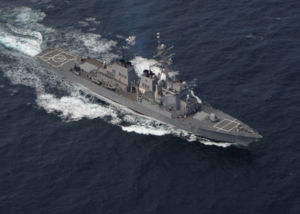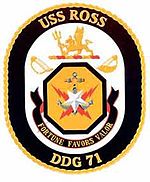- USS Ross (DDG-71)
-
For other ships of the same name, see USS Ross.

USS Ross in the Altantic OceanCareer (US) 
Name: USS Ross Namesake: Captain Donald K. Ross Ordered: 8 April 1992 Builder: Ingalls Shipbuilding Laid down: 10 April 1995 Launched: 22 March 1996 Commissioned: 28 June 1997 Homeport: Norfolk, Va. Status: in active service, as of 2011[update] Badge: 
General characteristics Class and type: Arleigh Burke-class destroyer Displacement: Light: approx. 6,800 long tons (6,900 t)
Full: approx. 8,900 long tons (9,000 t)Length: 505 ft (154 m) Beam: 66 ft (20 m) Draft: 31 ft (9.4 m) Propulsion: 4 General Electric LM2500-30 gas turbines, two shafts, 100,000 total shaft horsepower (75 MW) Speed: >30 knots (56 km/h) Range: 4,400 nautical miles at 20 knots
(8,100 km at 37 km/h)Complement: 33 Officers
38 Chief Petty Officers
210 Enlisted PersonnelSensors and
processing systems:• AN/SPY-1D 3D Radar
• AN/SPS-67(V)2 Surface Search Radar
• AN/SPS-73(V)12 Surface Search Radar
• AN/SQS-53C Sonar Array
• AN/SQR-19 Tactical Towed Array Sonar
• AN/SQQ-28 LAMPS III Shipboard SystemElectronic warfare
and decoys:• AN/SLQ-32(V)2 Electronic Warfare System
• AN/SLQ-25 Nixie Torpedo Countermeasures
• MK 36 MOD 12 Decoy Launching System
• AN/SLQ-39 CHAFF BuoysArmament: 1 × 29 cell, 1 × 61 cell Mk 41 vertical launch systems with 90 × RIM-156 SM-2, BGM-109 Tomahawk or RUM-139 VL-Asroc missiles
2 × Mk 32 triple torpedo tubes
1 × Mark 45 5/54 in (127/54 mm)
2 × 25 mm chain gun
4 × .50 caliber (12.7 mm) guns
2 × 20 mm Phalanx CIWSAircraft carried: 1 SH-60 Sea Hawk helicopter can be embarked Motto: Fortune Favors Valor USS Ross (DDG-71) is an Arleigh Burke-class guided-missile destroyer in the United States Navy. She was the second Navy ship of that name, and the first named in honor of Captain Donald K. Ross (1910–1992), who was awarded the Medal of Honor for his heroism during the attack on Pearl Harbor.
Ross's keel was laid on 10 April 1995 by Ingalls Shipbuilding in Pascagoula, Mississippi and her christening was held a year later, sponsored by Helen Ross, widow of Capt. Ross. Her plankowning crew moved aboard in April 1997 and sailed her to Galveston, Texas for the commissioning on 28 June 1997.
Contents
1990s
After commissioning, Ross set sailed for a Combat Systems Ship Qualification Trial, which lasted six weeks, and then sailed back to Pascagoula for three months for her Post Shakedown Availability (PSA). She was then returned to her homeport of Portsmouth, Virginia and completed the Basic Training Phase: Engineering Certification, CART II, TSTA I, and III, Cruise Missile Tactical Qualification, Final Evaluation Period (FEP), and Logistics Management Assessment.
Ross completed her Intermediate Training Phase and set sail early in 1999 as part of the USS Theodore Roosevelt Battle Group, which had sortied for a Joint Task Force Exercise to prepare for an upcoming six-month deployment set to commence on 26 March 1999. During this deployment to the Mediterranean and Adriatic Seas Ross participated in Operation Allied Force. On 22 September she returned to Norfolk.
2000s
On 15 May 2000 she set sail for Northern Europe in order to participate in the Baltic Operations (BALTOPS) 2000. She served as the flagship for the Commander of Carrier Group Eight, and together with the USS Peterson (DD-969) operated with more than 50 ships from the numerous European countries. During these exercises the destroyer visited Stockholm, Sweden and Kiel, Germany before returning to the United States in late June.
On 16 October 2001, Ross was deployed to the Mediterranean Sea and Persian Gulf in support of Operation Enduring Freedom, and conducting operations in support of the U.N. resolutions against Iraq. During this deployment, Ross was again part of the USS Theodore Roosevelt Battle Group.
On 6 June 2005, a .50 caliber machine gun on her deck fired while leaving a shipyard. The single .50 caliber bullet struck a nearby barge and two washing machines within the barge. The gun was discharged while performing a check on its firing operation.[1]
Later in 2005, Ross participated in UNITAS 47-06 in place of the USS Thomas S. Gates (CG-51) due to the damage to Pascagoula created by Hurricane Katrina. Ross enjoyed liberty in Curaçao, St. Maarten, and Rio de Janeiro while participating in the multi-ship exercise with naval forces from Argentina, Brazil, Spain, and Uruguay. During the return home, Ross encountered heavy seas at high speeds resulting in a tear in her hull. The crew isolated her flooding and performed de-watering during the remainder of the journey up the Atlantic coast eventually arriving in Norfolk in time for Thanksgiving.
In 2006, Ross returned from a six month deployment to the Mediterranean Sea as part of NATO's Standing Maritime Group. She conducted over 850 vessel queries, commanded over 17 different ships from various nations, performed over 40 helicopter landings and takeoffs and 41 port visits to six different countries and 14 different ports. From 1 May 2006 to 7 November 2006, Ross traveled over 64,000 nautical miles (120,000 km)). In Alicante, Spain in August 2006, Ross became the NATO flagship, embarking the American commander of the standing maritime group. Her mission was to perform as part of Operation Active Endeavour; deterring terrorism, smuggling and human trafficking in the Mediterranean.
Upgrade
On November 12, 2009, the Missile Defense Agency announced that Ross would be upgraded during fiscal 2012 to RIM-161 Standard Missile 3 (SM-3) capability in order to function as part of the Aegis Ballistic Missile Defense System.[2]
References
- ^ [1]
- ^ "MDA announces next 6 BMD ships", Navy Times, 12 November 2009.
This article includes information collected from the Naval Vessel Register, which, as a U.S. government publication, is in the public domain.
External links
Arleigh Burke-class destroyer Flight I ships Arleigh Burke · Barry · John Paul Jones · Curtis Wilbur · Stout · John S. McCain · Mitscher · Laboon · Russell · Paul Hamilton · Ramage · Fitzgerald · Stethem · Carney · Benfold · Gonzalez · Cole · The Sullivans · Milius · Hopper · Ross
Flight II ships Flight IIA ships 5"/54 variant5"/62 variantWinston S. Churchill · Lassen · Howard · Bulkeley · McCampbell · Shoup · Mason · Preble · Mustin · Chafee · Pinckney · Momsen · Chung-Hoon · Nitze · James E. Williams · Bainbridge · Halsey · Forrest Sherman · Farragut · Kidd · Gridley · Sampson · Truxtun · Sterett · Dewey · Stockdale · Gravely · Wayne E. Meyer · Jason Dunham · William P. Lawrence · Spruance · Michael Murphy
List of destroyers of the United States Navy · List of destroyer classes of the United States NavyCategories:- Arleigh Burke class destroyers
- Active destroyers of the United States
- United States Navy Colorado-related ships
- Ships built in Mississippi
- 1996 ships
- United States Navy Kansas-related ships
Wikimedia Foundation. 2010.
